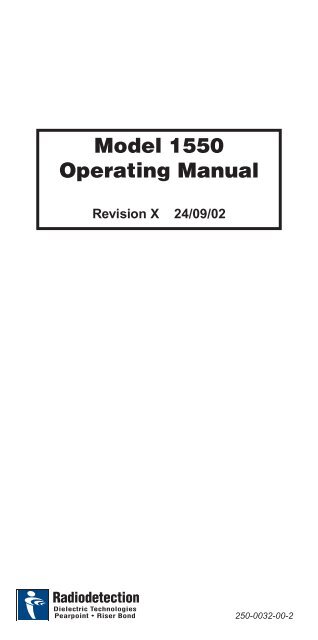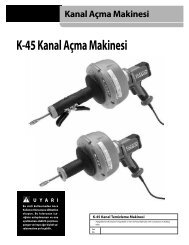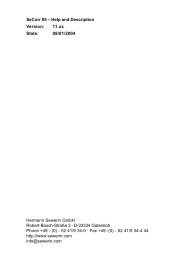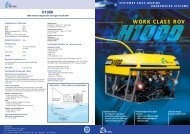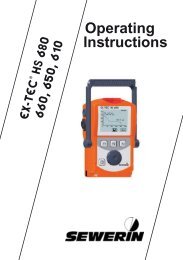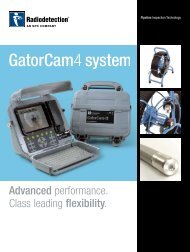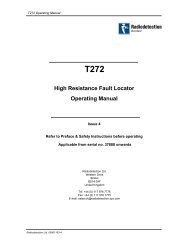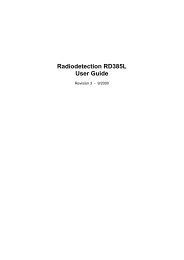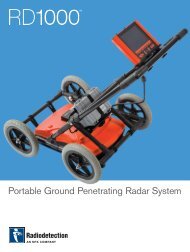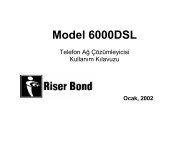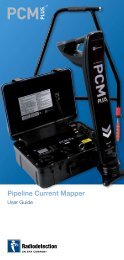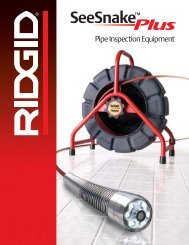Model 1550 Operating Manual
Model 1550 Operating Manual
Model 1550 Operating Manual
Create successful ePaper yourself
Turn your PDF publications into a flip-book with our unique Google optimized e-Paper software.
<strong>Model</strong> <strong>1550</strong><strong>Operating</strong> <strong>Manual</strong>Revision X 24/09/02250-0032-00-2
Description<strong>Model</strong> <strong>1550</strong> <strong>Operating</strong> <strong>Manual</strong><strong>Model</strong> <strong>1550</strong> is a cable fault locator which uses Time DomainReflectometry (TDR). Electrical pulses are transmitted into thecable, and a portion of the pulse energy will be reflected back tothe instrument from cable discontinuities or faults. Discontinuitiesare typically cable joints, changes in cable type or the far end ofthe cable under test, whereas faults are typically short circuits,open circuits, or high resistance joints.The pulses will travel at acertain velocity which will depend on the insulation between the twoconductors. <strong>Model</strong> <strong>1550</strong> displays the information in the form of atrace on an LCD screen, where reflections show as deviations froma horizontal line. The transmitted pulse is also displayed at the lefthandside of the screen.<strong>Model</strong> <strong>1550</strong> may be used on any cable consisting of at least twometallic elements, one of which may be the armouring or screenof the cable. The instrument is supplied with one of four test leadoptions to optimise measurements on 100 ohm twisted pair, 75 ohmcoaxial, 50 ohm coaxial or 25 ohm power cable. The power cabletest lead is fused and has a blocking filter to allow working on livecables up to 600V rms or peak DC.The instrument has a maximum range of 9800ft.<strong>Model</strong> <strong>1550</strong> is designed for ease of use with minimal operatorcontrols. Direct controls are provided for Range, Cursor, Backlightand On/Off, while a Mode Control allows access to variablefunctions. These variable functions are:a) Cable type - the choices available are twisted pair(100 ohm ), coaxial (75 ohm), coaxial (50 ohm) andpower cable (25 ohm). Choosing the cable typeselects a preset sensitivity, the impedance setting anda default Velocity of Propagation (VOP).b) VOP - this may be adjusted independently of thedefault value.c) Measurement units - these may be displayed asfeet or metres.d) The LCD screen contrast.<strong>Model</strong> <strong>1550</strong> is ruggedly constructed, is shower resistant and has awide operating temperature range, allowing all-weather use.1 Riser-Bond Instruments 250-0032-00-2
<strong>Model</strong> <strong>1550</strong> <strong>Operating</strong> <strong>Manual</strong>Description of ControlsPower ON/OFFPush – On; Push – Off. Unit turns itself off 5 minutes after thelast key press.Back-lightPush to turn on, push again to turn off. Light turns itself off after3 minutes.RangeAllows the user to cycle through the ranges 9800 ft (3000m),3300 ft (1000m), 980 ft (300m), 330 ft (100m), 98 ft (30m) and33 ft (10m) . (Ranges are nominal @ VOP = .67).Cursor LeftMoves the cursor left in Trace display, or after pressing theMode button, cycles through the options available for cabletype, distance units, velocity factor and contrast.Cursor RightMoves the cursor right in Trace display, or after pressing theMode button, cycles through the options available for cabletype, distance units, velocity factor and contrast.ModeFunction key used to select user variable parameters. Themode returns to normal operation 30 seconds after last buttonpress.When in “Mode” the vertical cursor is dotted, in normaloperation the cursor is solid.The selected function is highlighted on the LCD. Functionsavailable are:a) Cable type Symbols seen are:Coaxial cableImpedance = 50 ohmVOP = 0.67Coaxial cableImpedance = 75 ohmVOP = 0.82Twisted pair cableImpedance = 100 ohmVOP = 0.67Power cable, via blocking filterImpedance = 25 ohmVOP = 0.54Riser-Bond Instruments 250-0032-00-2 2
<strong>Model</strong> <strong>1550</strong> <strong>Operating</strong> <strong>Manual</strong>b) Distance UnitsAllows the change of measurement units from feet to metres andvice versa.c) Velocity of Propagation SettingAllows the adjustment of the Velocity Factor between 0.20 and0.99 (see look-up table in the VELOCITY OF PROPAGATIONsection of thismanual)d) Contrast SettingAllows the user to adjust the contrast of the LCD manually usingthe cursor keys. Contrast symbol appears at top center ofthe trace display:On Screen Information1Transmit Pulse2Battery state indicator: Symbol flashes when batteries are low. Itchanges to a permanent symbol when the batteries need urgentreplacement. Unit performance cannot be guaranteed when thepermanent battery symbol appears.3456789Contrast IndicationVelocity of Propagation (VOP)Cursor: Positioned at start of reflected pulseRe• ected pulseDistance to fault (ft. or m.)Cable Type: see (a) on previous page)Range: 9800ft (3000m), 3300ft (1000m), 980ft (300m), 330ft(100m), 98ft (30m), 33ft (10m). Nominal @ 0.67 VOP3 Riser-Bond Instruments 250-0032-00-2
<strong>Model</strong> <strong>1550</strong> <strong>Operating</strong> <strong>Manual</strong>OperationEnsure that the appropriate test lead is firmly fitted into the slot at thetop rear of the instrument.Connect the test lead clips to the cable under test. Switch theinstrument on. The screen will display a trace. The VOP and cabletype will be that used when the unit was last switched off. The rangewill be the maximum i.e 9800ft (3000m).Select a range according to the estimated length of cable under test.For example, for 820ft (250m) cable select the 980ft (300m) range, or3300ft (1000m) range if the VOP is less than 0.55.Use the mode control to select a cable type according to the cableunder test.Examine the trace for deflections from the horizontal line across thescreen occurring after the transmit pulse.Looking at the trace from left to right, move the cursor to the firstedge of the first significant deflection seen (not the transmit pulse).Set the cursor one pixel to the left of the deflection, and read off thedistanceSubtract 4ft (1.3m), from the displayed result, for power cablemeasurements subtract 3ft (1m); this allows for internal connectionsand the test lead.Interpretation of the trace information is straightforward. A risingreflection indicates an open circuit, a high series resistance or atransition to a cable with a higher characteristic impedance. A fallingreflection indicates a short circuit, a ‘tee’ joint (tap), or a transition toa cable with a lower characteristic impedance. Shorts and opens willshow full screen reflections whilst poor connections or other slightdiscontinuities will give much smaller reflections.If no reflection is seen, there may be no fault, or the fault is beyondthe range displayed, or beyond the instrument sensitivity. If it appearsthere is a fault near to, or within, the transmit pulse, select the nextlower range.Riser-Bond Instruments 250-0032-00-2 4
<strong>Model</strong> <strong>1550</strong> <strong>Operating</strong> <strong>Manual</strong>Examples of traces are shown on the inside front cover and aredescribed below:Shows the VOP at 0.67, the range at 980ft, the cabletype selected is 50 ohm coax and the distance to anopen circuit is 435.2 ft.Shows the VOP at 0.82, the range at 300 m, the cabletype selected is 75 ohm coax and the distance to a shortcircuit is 147.6 m.Shows the VOP at 0.67, the range at 300 m, the cabletype selected is twisted pair, the distance to a highresistance joint is 151.9 m, and an open circuit at 250.8mShows the VOP at 0.54, the range at 100 m, the cabletype selected is power and the distance to a ‘tee’ orbranch is 57.67 m. (Note: It is recommended that toobtain greatest accuracy, the test lead separation isminimised for power).Shows use on short range and an arrow points out thereflection from the end of the test lead.Shows effect of a short length on long range. What isshown is the reflection from a short circuit at 20m onthe 1000m range. The normal transmit pulse is showndotted. The reduction of the width of this pulse indicatesthat the fault is very near to the test point, so the rangeshould be reduced.5 Riser-Bond Instruments 250-0032-00-2
Velocity of Propagation (VOP)<strong>Model</strong> <strong>1550</strong> <strong>Operating</strong> <strong>Manual</strong>Unknown VOPTo determine the Velocity of Propagation if a good conductor isavailable, obtain a waveform and position the cursor at the start ofthe reflected pulse from a known feature (cable joint or cable end).Adjust the VOP until the displayed distance is equal to the distanceto the feature.If no sound conductor is available, the distance to the fault can bemeasured from both ends of the cable using an arbitrary VOP (thesame must be used at each end). The actual distance to the faultcan be calculated as in the following example:Total cable length = 250 m (from records or wheeled)Distance measured from first end = 90 mDistance measured from second end = 140 mActual distance from first end:90x 250 = 97.8m(90 + 140)If required, the instrument can then be reconnected at the first endand the VOP adjusted until the indicated distance is 97.8 m. Thisvalue of VOP can then be noted and used for subsequent faultlocation on the same type of cable.Typical pvf ValuesThe VOP values provided as defaults in the <strong>Model</strong> <strong>1550</strong> cable typesettings are based on experience and commonly found types. Thesefigures will be useful for most day to day applications.As an additional guide some more VOP figures are given below:Power Paper Oil Filled (PILC) 0.50 to 0.56Cross linked poly (XLPE) 0.52 to 0.58Twisted Pair Polyethylene 0.67Jelly filled poly 0.64PTFE (Teflon) 0.71Paper (Pulp .083µf/mile) 0.72Paper (Pulp .072µf/mile) 0.88Coax Foam Poly 0.82Air Spaced Coaxial 0.94Air 0.98Solid PE 0.677 Riser-Bond Instruments 250-0032-00-2
<strong>Model</strong> <strong>1550</strong> <strong>Operating</strong> <strong>Manual</strong>Basic Speci• cationItemNominal Range(VOP 0.67)ResolutionAccuracySensitivitySpeci• cation9800 ft (3000 m), 3300 ft (1000 m),980 ft (300 m),330 ft (100 m),98 ft (30 m), 33 ft (10 m)1% of range± 0.9% of range± 2.5V to ± 50mV for full scale deflection,automatically adjusted according to distanceand cable type.Transmit pulse Square pulse 5 V (nominal) unterminated .Width dependant on range. 7, 18, 62, 250,625, 2000 ns nominallyOutputImpedance2 x 4 mm shrouded sockets, 19 mm centresSelectable via cable type as 25, 50, 75 and100 W.Circuit Protection The unit will not be damaged by inadvertentdirect connection to 250 V AC rms 50/60 Hzor 400 V DC. However it is unsafe to use theunit in this way. For safe use on cablecarrying hazardous live voltages, theblocking filter test lead must be used.Velocity ofPropagation (VOP) Adjustable between 0.20 and 0.99Power Requirements9 V DC nominal - supplied by 6 R6Zinc Carbon or LR6 alkaline batteries(AA size) Battery life - 16 hours on alkalinebatteries at ambient temperature of 20°C (nobacklight).Environmental Water resistant to BS 2011, Part 2.1R/IEC 68-2-18, Test RaIEC 68: <strong>Operating</strong> temp -20° to +55°CStorage temp -30° to +70°CUnit survives field environmentincluding transportation in wheeled vehicleson normal roads.EMCEC directive 89/336/EEC as amended by ECdirective 93/68/EEC BS EN50082-1: 1992BS EN 55011:1991 (group1 class B). <strong>Model</strong><strong>1550</strong> is specified for operation in residential,commercial or light industrial environments.Riser-Bond Instruments 250-0032-00-2 8
<strong>Model</strong> <strong>1550</strong> <strong>Operating</strong> <strong>Manual</strong>SafetyDisplayDimensionsWeighta) <strong>Model</strong> <strong>1550</strong> unit with coaxial test leads(50 ohm or 75 ohm): For use on safevoltages only, below 30V AC rms (42.4V pk)or 60V DC.b) <strong>Model</strong> <strong>1550</strong> unit with twisted pair testleads: For use on TelecommunicationsNetwork Voltages, and also on safe voltagesSee BS EN 41003:1997c) <strong>Model</strong> <strong>1550</strong> unit with Blocking Filter testleads: For use on cables carrying hazardouslive voltages, in excess of 30V AC rms(42.4V pk) or 60V DC. The Blocking filtercomplies with: EC directive 73/23/EECas amended by EC directive 93/68/EEC. BSEN 61010- 1:1993 + amendment 1:1995 BSEN 61010-2-031:1995 Installation CategoryIII, 600V 50/60Hz AC rms, or DC.128 x 64 pixel liquid crystal graphics displaywith LED backlight.250 x 100 x 55mm2.4 lb (1.1 kg) including soft case, test lead,operating manual and batteries.Accessories<strong>Model</strong> <strong>1550</strong> is supplied with a carry bag, and this operating manual.Test leads should be ordered as required.Spares/Optional AccessoriesThe following items are available as spares / optional accessories.Riser BondDescription163-0042-00 50 ohm coax test lead163-0043-00 75 ohm coax test lead163-0044-00 100 ohm twisted pair test lead163-0045-00 25 ohm power cable test lead (blocking filter)230-0021-00 BNC to F adaptor210-0023-00 500 mA fuse for blocking filter test lead300-0026-00 Carry bag250-0032-00 <strong>Operating</strong> manual230-0091-01 Blocking filter crocodile clip - Red230-0091-00 Blocking filter crocodile clip - Black9 Riser-Bond Instruments 250-0032-00-2
<strong>Model</strong> <strong>1550</strong> <strong>Operating</strong> <strong>Manual</strong>Product Safety DataWARNINGIt is unsafe to connect the 50 ohms, 75 ohmsand twisted pair test leads (available asstandard or optional accessories) to cablesenergised to hazardous live voltages.Hazardous live voltages are defined as:- greater than 30V r.m.s (42.4V pk) or 60VDC. However, connection of the twisted pairlead to Telecommunication Network Voltagesis allowed.Energised cables can be dangerous due toelectric shock hazard or due to arcing(initiatedby short circuit) which can cause burns orfires.The Fused Test Leads with Blocking Filter areused to protect against arcing and electricshock when used on cables which are ormight become energised up to 600Vrms 50/60Hz or 600V DC, Installation Category III, with amaximum prospective system fault current of46 kA. Connection to energised cables shouldonly be carried out by trained personnel.Test leads must be connected to <strong>Model</strong> <strong>1550</strong>before connecting to the cable to be tested,and removed from the cable before removingfrom <strong>Model</strong> <strong>1550</strong>. Depending on theapplication, industry and location additionalsafety precautions may be necessary. Consultyour safety advisor.Composition / Toxic HazardsIn its normal condition, the <strong>Model</strong> <strong>1550</strong> presents no toxic hazards.However, in certain circumstances, the following could apply:IncinerationSome of the components included in this assembly are constructedwith resins and other chemicals which give off toxic fumes uponincineration.Acidic or caustic compoundsSome of the components, particularly electrolytic capacitorsincluded in the assembly, are constructed with acidic or causticcompounds. In the event of damaged items coming into contactwith the skin, washing the affected areas with cold water isrecommended. Should eyes be rubbed by hands contaminatedwith the above compounds, the eyes must be thoroughly rinsed withclean water and medical attention sought urgently.Riser-Bond Instruments 250-0032-00-2 10
<strong>Model</strong> <strong>1550</strong> <strong>Operating</strong> <strong>Manual</strong>DisposalThe unit is manufactured using recyclable items. Take reasonableprecautions that are normally exercised with the disposal ofelectrical/electronic equipment and batteries. If in doubt contactyour local authority.ServicingThis instrument contains no user serviceable item other than thebatteries. In the unlikely event of failure, please return to the nearestservice center for replacement. In order to maintain the accuracyof thisequipment, it is recommended that annual calibration andmaintenance is carried out. Riser-Bond Instruments have thenecessary equipment and expertise and would be willing to quotefor provision of this service if requested.Battery Selection and InstallationThe unit operates from six AA (R6/LR6) size batteries. Typical life is 8hours from zinc carbon and 16 hours from alkaline batteries. Thesecells are not rechargeable and recharging must not be attempted.The batteries should be replaced when the low battery symbol isvisible.WARNINGDisconnect the test leads from anycable before removing the battery coverTo • t the batteries:u Place the instrument face downu Undo the battery compartment retainer (1⁄4 turn anti-clockwise)u Lift off the coveru Note the polarity markings of the batteryu Insert the batteries into their respective battery tubes and fit in theunit as belowu Replace the cover and re-fasten the retainer (1⁄4 turn clockwise)DO NOT OVERTIGHTEN11 Riser-Bond Instruments 250-0032-00-2
<strong>Model</strong> <strong>1550</strong> <strong>Operating</strong> <strong>Manual</strong>Riser-Bond Instruments 250-0032-00-2 12


